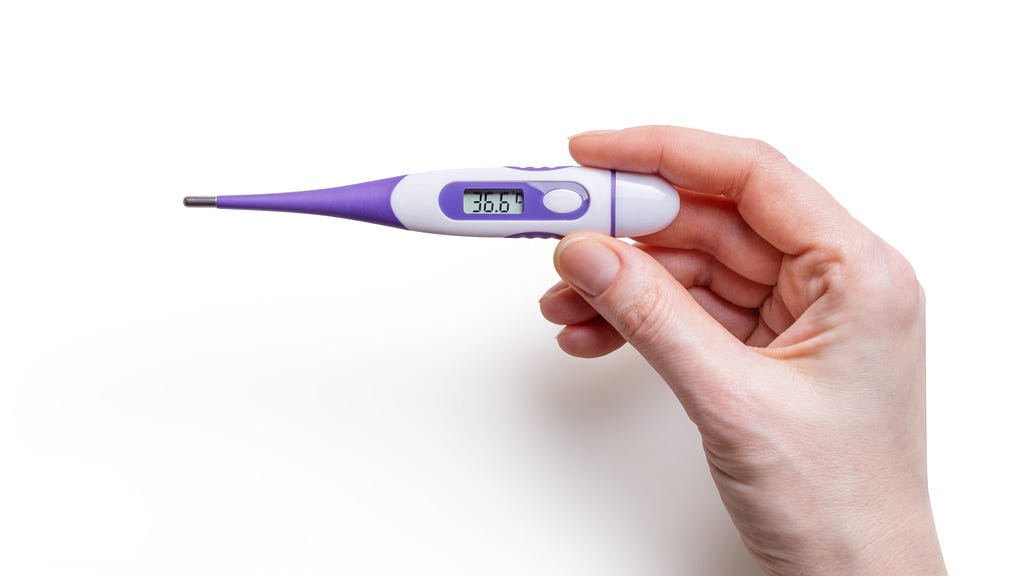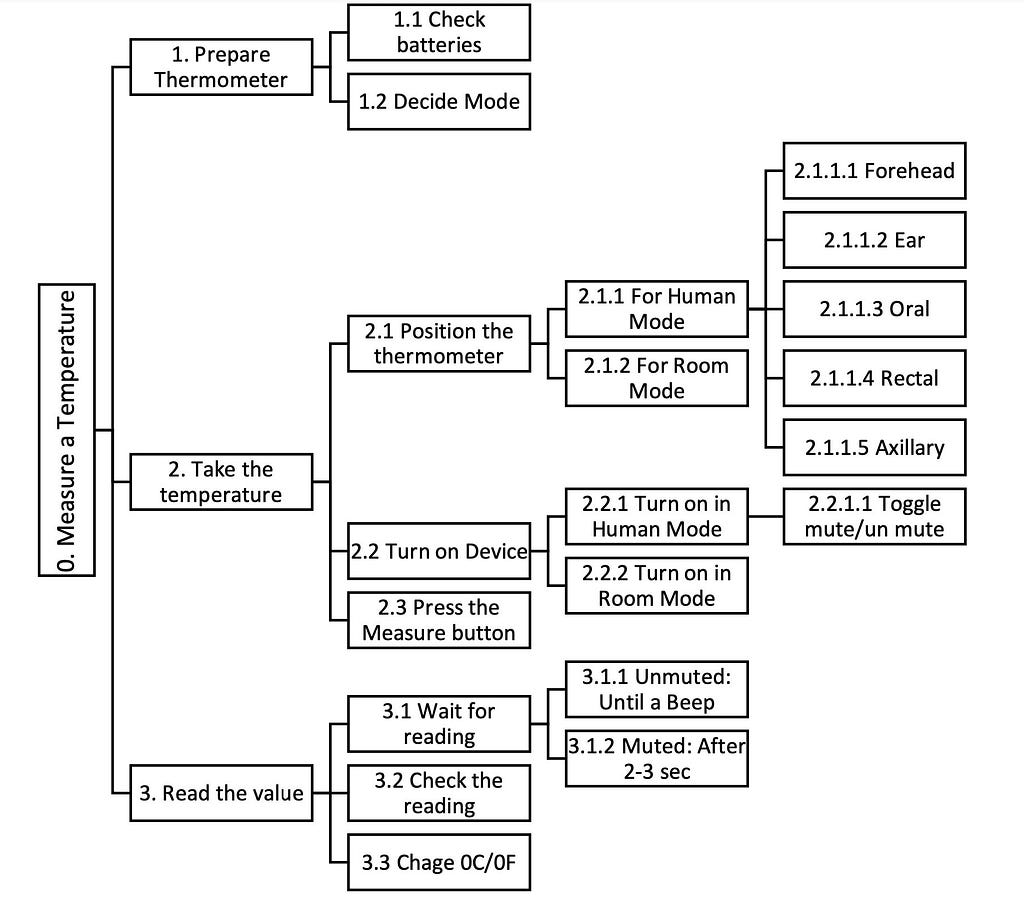About the product:
An infrared thermometer, also called a non-contact thermometer, is a device used to measure the temperature of a body or a surrounding space without coming into contact, making it a hygienic and non-invasive way to measure temperature. This product can also store previously taken temperature readings.
Task Analysis: Measure a Temperature
This task analysis assumes that the user has already unboxed and removed protective covers and is familiar with the device’s features and functions.
Inclusive Design Evaluation
Functional Limitations
The primary limitation of an infrared thermometer is the accuracy of reading which can be affected by factors such as distance from the object, the angle at which the thermometer is aimed, and external factors such as dust or moisture in the environment.
Elaborating on these factors:
Water Exposure: Unlike the traditional thermometers, we submerge them in water to clean the tips before taking the temperature. It is advised never to immerse the device in water or other liquid instead, use an alcohol swab or cotton swab moistened with 95% alcohol to clean the casing and measuring probe.
High Humidity (>95%): The manual advised not to use the device in highly humid conditions implying inaccurate reading or damage to the device.
Measuring Distance: The device should be within 1.5 inches of the person for an accurate temperature reading.
Clean Surface: The targeted surface should be clean, dust-free, and without any hindrances from other things like hair and sweat must be avoided for error-free reading.
Loss of Memory: The storage of temperature readings is lost after removing the batteries from the device.
Hand Grasp: The product requires a specific grip size and strength. It excludes kids under the age of 12 years due to small hands and individuals with limited dexterity due to essential tremors or in situations of limited mobility.
Batteries: It is a digital thermometer; a spare set of batteries must be handy to change them in an emergency.
Alternatives:
Several types of thermometers can be used to measure human body temperature. For suggesting the alternative options, we considered that the user is interested in purchasing or using an electronic thermometer, eliminating the Mercury or traditional thermometers, and considering that the product will be used in a house setting, striking off the commercial or hospital equipment. Therefore, the considered thermometers are digital Thermometers and Ear Thermometers. Each type of thermometer has advantages and disadvantages, and the choice depends on the situation and individual preference.

When exploring an alternative, a digital thermometer might be a better product for high-humidity environments such as in tropical areas like Mumbai. The temperature sensor used to measure the body’s temperature isn’t affected by humidity, so it gives a perfect reading as in other dry environments.
However, the product requires close contact with the body, orally or rectally, or under the arm to function and might affect the temperature accuracy if taken too close to eating or drinking time. Further, using the same thermometer for rectal and oral readings isn’t ideal, so one must purchase and label two thermometers.

Similarly, if the user opts for an ear thermometer, which also works using infrared technology, it measures the temperature of the eardrum without any contact. Like digital thermometers, their functionalities aren’t affected by humid environments. In addition, it seems an ideal product for children as it does not require contact with oral or rectal parts. Yet, they aren’t recommended for infants under six months due to the ear canal size. Further, the orientation of the product plays a crucial role in accurate results, and the readings may be affected by earwax buildup or ear infections.
In summary, infrared thermometers may be less accurate than digital or ear thermometers in humid environments. But digital thermometers require contact with the body, and ear thermometers may be affected by earwax buildup. So finally, when selecting a thermometer, the choice will depend on the user’s needs and settings.
Usability Evaluation:
The usability study of the GoodBaby Infrared Thermometer aims to assess the device’s ease of use, efficiency, and accuracy. We plan on achieving this by understanding how intuitive the product is to use without using a manual or searching online. We will further do this by timing the individual tasks and calculating the error rate with each job.
The tasks to be performed in the study are:
Task 1: Use this thermometer to take your temperature behind your ear
Task 2: Use this thermometer to take the researcher’s forehead temperature in a mute setting
Task 3: Change the temperature unit (e.g., Change from 0F to 0C)
Task 4: Use the thermometer to take the room’s temperature.
Task 5: Recall the previous two measured readings
The above tasks will be followed in the same written order since a few jobs require the previous tasks to be performed first. For this analysis, we plan to recruit users who are adults above the age of 12 years who do not possess limited mobility or grip strength affecting their use of the product.
The usability tasks were devised considering the usual tasks a user will perform using this device, such as measuring the temperature, changing the unit, and muting the device before measuring the temperature of an unwell person while sleeping. Further, some tasks, like measuring the room temperature, may differ from the device’s primary function. Still, it seems less intuitive and requires pre-knowledge of the product or the presence of a user manual to figure out the feature for the first usage. Therefore, we included it in the tasks to test our perception of this feature. Another hidden but valuable feature is temperature unit conversion from 0F to 0C and vice versa. This task is considered a common feature in all thermometers, showcasing both temperature units or proving an option to convert like in this thermometer. Lastly, accessing the last readings is essential for maintaining a temperature record for kids or anyone requiring taking temperature multiple times a day or for a prolonged time. Thus, testing the intuitiveness and effectiveness of the feature is important.




